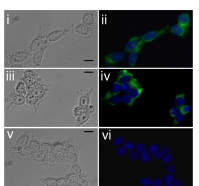Development of a novel GFP-based biosensor

Molecular detection is a staple of biological and environmental research. It is traditionally approached using a two-antibody system; the primary antibody specifically binds to the molecule of interest, and the secondary antibody, which is fluorescently tagged, binds the species-specific constant region of the primary antibody. Many efforts have been made to simplify this system using alternative molecules; in particular, our lab engineered a green fluorescent protein (GFP) based biosensor with dual antibody-like binding loops (GFAb) capable of recognizing a target molecule without interrupting the intrinsic fluorescence of GFP.

Permeablized HEK-293 cells were incubated with: (i and ii) GAPDH binding G6 GFAb, (iii and iv) an anti-GAPDH antibody followed by fluorescent Alexa488 secondary antibody, and (v and vi) the parent scaffold 20–5-8, and cells were monitored for green fluorescence (GFAb-derived: i, ii, v, and vi or Alexa488-derived: iii and iv). DAPI was used to stain the nucleus (blue). (Scale bar, 20 micron)
